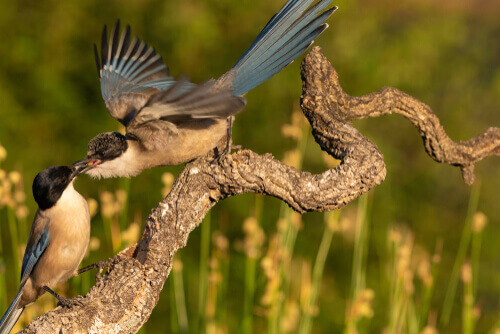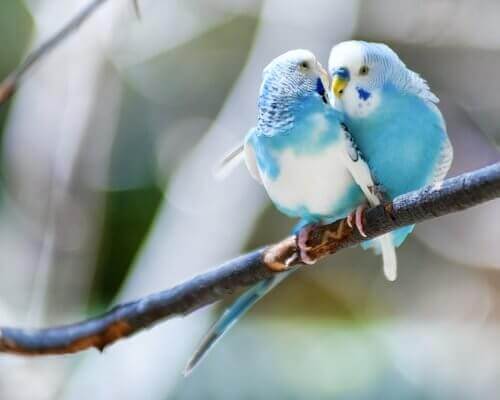Matrilineal Polyandry in the Animal Kingdom


Written and verified by the biologist Ana Díaz Maqueda
The term polyandry comes from the Greek polýs (many) and Andros (man), and refers to the females of the animal kingdom that copulate with more than one male to ensure viable and fertile offspring.
Polyandry is one of the main three types of mating in the animal world, along with monogamy and polygyny (in the latter a male copulates with many females) which Darwin described in the 19th century.
Until recently, monogamy was considered the most typical form of female sexual behavior. This may be due in part to the predominantly male scientific world of the 19th century focusing on preconceptions of female behavior. Also, recent access to genetic testing in animal offspring revealed that seemingly monogamous episodes actually weren’t.
Today we know monogamy is a nuanced reproductive strategy. In fact, true monogamy requires the female to become unreceptive after copulation. Continue reading to find out more about this rather interesting topic.
Breaking the myth of monogamy
The behavior of birds used to be one of the best ways to explain and understand animal sexuality. For decades, direct observation of their behavior suggested they normally mated for life.
This belief disappeared after the first studies of DNA in the offspring of “monogamous” birds. It revealed the chicks had different fathers. After this, the paradigm of monogamous birds and of sexual relations as we understood it were refuted.

The benefits of polyandry in the animal kingdom
Historically, it’s been considered that females obtained everything they needed from a single mate. That is, the fertilization of all their eggs was the result of a single sperm supply.
Furthermore, researchers assumed that female reproductive success is limited by the availability of resources such as food. Meanwhile, male reproductive success had more to do with the number of females with whom they copulated.
Today we know there are other modes of reproduction and reproductive strategies. In fact, they’re equally beneficial from an evolutionary perspective. This is because they’ve been maintained over time and thus are viable. Specifically, polyandry offers the following advantages for those species that practice it:
- More sperm and more genetic variability
- It ensures greater viability of the offspring in species with sperm competition — the sperm of several males compete to reach the oocyte within the female
- Some studies show that the presence of different samples of semen increases the strength of the embryo or embryos, through genetic mechanisms. For example, it promotes the selection of sperm with “more compatible genes”
- In some species, males offer food to females as part of courtship, which would increase female fertility
- Polyandry appears to increase the scope of parental care on the part of the male
- Also, it decreases the risk of infanticide because the males can’t tell if the young are theirs — mainly to copulate with the same female again
- There are genetic mechanisms that promote the selection of sperm with “more compatible genes”
How does polyandry in the animal kingdom affect males?
Just as the females have their own strategies, species with polyandrous males also have their mechanisms to compete with the rest.
When a female copulates with several males in a short period of time, the sperm will compete with each other to reach the oocyte. Therefore, in some cases, males have strategies to avoid this competition:
- In some species, the males stay around the females to deter possible competitors
- They can also insert plugs at the entrance of the female’s vagina to keep her from copulating with other males — this is the case with rats and mice
- In other species, males can control the amount of sperm they ejaculate based on the number of potential competitors
- Some males secrete proteins, together with their sperm, to cancel the receptivity of the female or to accelerate the laying of eggs (in oviparous species)

Could this be the best reproductive strategy for females?
There are no better or worse reproductive strategies. The pressures of natural selection have led many species to the evolutionary moment we currently find ourselves in. The factors that may have caused the emergence of one strategy or another could be countless.
Thanks for reading.
The term polyandry comes from the Greek polýs (many) and Andros (man), and refers to the females of the animal kingdom that copulate with more than one male to ensure viable and fertile offspring.
Polyandry is one of the main three types of mating in the animal world, along with monogamy and polygyny (in the latter a male copulates with many females) which Darwin described in the 19th century.
Until recently, monogamy was considered the most typical form of female sexual behavior. This may be due in part to the predominantly male scientific world of the 19th century focusing on preconceptions of female behavior. Also, recent access to genetic testing in animal offspring revealed that seemingly monogamous episodes actually weren’t.
Today we know monogamy is a nuanced reproductive strategy. In fact, true monogamy requires the female to become unreceptive after copulation. Continue reading to find out more about this rather interesting topic.
Breaking the myth of monogamy
The behavior of birds used to be one of the best ways to explain and understand animal sexuality. For decades, direct observation of their behavior suggested they normally mated for life.
This belief disappeared after the first studies of DNA in the offspring of “monogamous” birds. It revealed the chicks had different fathers. After this, the paradigm of monogamous birds and of sexual relations as we understood it were refuted.

The benefits of polyandry in the animal kingdom
Historically, it’s been considered that females obtained everything they needed from a single mate. That is, the fertilization of all their eggs was the result of a single sperm supply.
Furthermore, researchers assumed that female reproductive success is limited by the availability of resources such as food. Meanwhile, male reproductive success had more to do with the number of females with whom they copulated.
Today we know there are other modes of reproduction and reproductive strategies. In fact, they’re equally beneficial from an evolutionary perspective. This is because they’ve been maintained over time and thus are viable. Specifically, polyandry offers the following advantages for those species that practice it:
- More sperm and more genetic variability
- It ensures greater viability of the offspring in species with sperm competition — the sperm of several males compete to reach the oocyte within the female
- Some studies show that the presence of different samples of semen increases the strength of the embryo or embryos, through genetic mechanisms. For example, it promotes the selection of sperm with “more compatible genes”
- In some species, males offer food to females as part of courtship, which would increase female fertility
- Polyandry appears to increase the scope of parental care on the part of the male
- Also, it decreases the risk of infanticide because the males can’t tell if the young are theirs — mainly to copulate with the same female again
- There are genetic mechanisms that promote the selection of sperm with “more compatible genes”
How does polyandry in the animal kingdom affect males?
Just as the females have their own strategies, species with polyandrous males also have their mechanisms to compete with the rest.
When a female copulates with several males in a short period of time, the sperm will compete with each other to reach the oocyte. Therefore, in some cases, males have strategies to avoid this competition:
- In some species, the males stay around the females to deter possible competitors
- They can also insert plugs at the entrance of the female’s vagina to keep her from copulating with other males — this is the case with rats and mice
- In other species, males can control the amount of sperm they ejaculate based on the number of potential competitors
- Some males secrete proteins, together with their sperm, to cancel the receptivity of the female or to accelerate the laying of eggs (in oviparous species)

Could this be the best reproductive strategy for females?
There are no better or worse reproductive strategies. The pressures of natural selection have led many species to the evolutionary moment we currently find ourselves in. The factors that may have caused the emergence of one strategy or another could be countless.
Thanks for reading.
All cited sources were thoroughly reviewed by our team to ensure their quality, reliability, currency, and validity. The bibliography of this article was considered reliable and of academic or scientific accuracy.
- Boulton, R. A., & Shuker, D. M. (2013). Polyandry. Current Biology, 23(24), R1080-R1081.
- García-González, F., & Simmons, L. W. (2007). Paternal indirect genetic effects on offspring viability and the benefits of polyandry. Current Biology, 17(1), 32-36.
- Kvarnemo, C., & Simmons, L. W. (2013). Polyandry as a mediator of sexual selection before and after mating. Philosophical Transactions of the Royal Society B: Biological Sciences, 368(1613), 20120042.
- Marshall, D. J., & Evans, J. P. (2007). Context-dependent genetic benefits of polyandry in a marine hermaphrodite. Biology Letters, 3(6), 685-688.
- Oring, L. W. (1986). Avian polyandry. In Current ornithology (pp. 309-351). Springer, Boston, MA.
- Zeh, J. A., & Zeh, D. W. (1996). The evolution of polyandry I: intragenomic conflict and genetic incompatibility. Proceedings of the Royal Society of London. Series B: Biological Sciences, 263(1377), 1711-1717.
- Zeh, J. A., & Zeh, D. W. (1997). The evolution of polyandry II: post–copulatory defenses against genetic incompatibility. Proceedings of the Royal Society of London. Series B: Biological Sciences, 264(1378), 69-75.
This text is provided for informational purposes only and does not replace consultation with a professional. If in doubt, consult your specialist.








